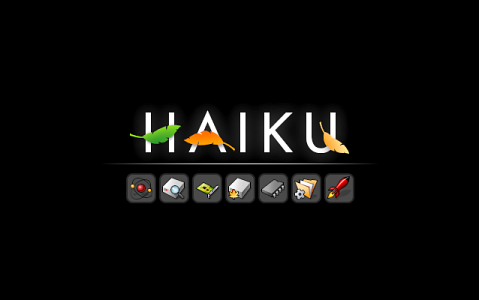Boot Loader
Haiku's Boot Loader Options can help when you experience hardware related problems or want to choose which Haiku installation to start, if you have more than one (maybe on an installation CD or USB stick). It's also handy if you have installed a software component that acts up and prevents you from booting Haiku, see Troubleshooting below.
To enter the Boot Loader Options, you have to press and keep holding the SHIFT key before the beginning of Haiku's boot process. If there's a boot manager installed, you can start holding SHIFT before invoking the boot entry for Haiku. If Haiku is the only operating system on the machine, you can begin holding the key while still seeing boot messages from the BIOS.
On computers that use UEFI for booting instead of the classic BIOS, you need to use the SPACEBAR instead of SHIFT.
 Boot Loader Options
Boot Loader Options
Once it's there, you're offered four menus:
| Select boot volume/state | Choose which Haiku installation/state to start (see Troubleshooting below). | |
| Select safe mode options | There are several options to try in case of hardware related trouble or if the system becomes unstable or unbootable because of a misbehaving add-on. When moving the selection bar to an option, a short explanation appears at the bottom of the screen. | |
|
| ||
| Select debug options | Here you'll find several options that help with debugging or getting details for a bug report. Again, a short explanation for each option is displayed at the bottom. | |
|
| ||
| If is activated, a warm reboot after a crash shows these additional options: | ||
|
| ||
| Select screen resolution | Lets you force a certain screen resolution and color depth. |
 Troubleshooting
Troubleshooting
If Haiku refuses to boot on your hardware from the get-go, try out setting different options under . Consider filing a bug report in any case.
On the other hand, if Haiku only suddenly acts up after you have installed some software, especially hardware drivers, you have several options to get Haiku bootable again so you can uninstall the offending package:
Activating will prevent most servers, daemons and the UserBootscript from being started.
Activating will prevent using any add-ons (drivers, translators, etc.) you have installed in the user hierarchy under your Home folder.
If activating solves your troubles by falling back to VESA graphics, you can make the setting permanent by removing the # of the line #fail_safe_video_mode true in the text file /boot/home/config/settings/kernel/drivers/kernel.
If the offending driver, add-on etc. is installed in the system hierarchy, things get a bit more complicated, because that area is read-only. Here, the comes into play. With it, you can navigate through the whole system hierarchy and disable the component that's messing things up for you by checking an entry with the SPACE or ENTER key. ESC returns you up one level to the parent directory.
Online, there's the guide Disabling components of packages showing how to make that setting stick.
Under you can specify what former "version" of Haiku to boot. Every time you un/install a package, the old state is saved and you can boot into it by choosing it from the list presented in the boot loader options.
So, if you encounter boot problems after installing some package, boot a Haiku state from before that time and uninstall the offending package. You can permanently revert to a specific Haiku revision as described in the topic SoftwareUpdater.
 Booting Haiku
Booting Haiku
After activating one or more options, you return to the main menu and continue booting, which presents you with this boot screen:

If everything works OK, one symbol after another quickly lights up.
The different symbols roughly correspond to these boot stages:
| Atom | Initializing modules. | |
| Disk + magnifier | Creating rootfs (/) and mounting devfs (/dev). | |
| Plug-in card | Initializing device manager. | |
| Boot disk | Mounting boot disk. | |
| Chip | Loading CPU specific modules. | |
| Folder | Final initialization of subsystems. | |
| Rocket | Launch_daemon has started the system. |